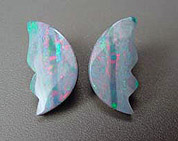
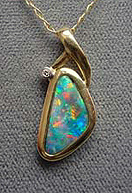
An assembled stone is one that is constructed out of two or more materials. This category includes, for example, such creations as: doublets and triplets, intarsias and inlays, foilbacks and Mabe pearls. There are four common reasons why such pieces are made:
#1) To make use of otherwise unsuitable or fragile gem material.
#2) To create an entirely new category of gem product.
#3) To provide an inexpensive simulant for an expensive natural gem.
#4) To deceive a buyer into thinking the piece is something more valuable.
Most gem lovers are familiar with doublets and triplets, especially the opal variety. Opal frequently occurs as thin seams of material within a host or matrix rock. Although beautifully colored, such deposits are so thin and fragile as to be useless for jewelry. By cementing one of these thin layers to a strong backing (almost always black onyx or something similar) two goals can be acheived. The strong backing provides the thickness and strength needed for setting, and the dark color makes the usually translucent opal layer look like black or dark grey opal. The color play in the gem material is then displayed in high contrast against this dark background. An opal doublet must still be set and worn with care, as the exposed opal surface is relatively soft. Well done pieces look wonderful, and make affordable, reasonably durable, opal jewelry.


(Boulder and matrix opals have sometimes been referred to as "natural doublets" although, in my view, this term is an oxymoron. These natural materials are fashioned with their thin opal seams showing on the surface of the natural matrix in which they formed and are not assembled stones.)

Opal triplets have a colorless, usually somewhat domed, cap cemented to the doublet. Such caps are made of scratch resistant, tough materials, like rock crystal quartz, synthetic colorless spinel or even synthetic colorless sapphire. Although such products are quite durable, they lack the natural appearance of well made doublets.
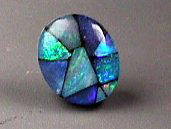
Since ammolite has gained in popularity and recognition as a gem material, another type of doublet and triplet have become common. Ammolite is the trade name for the fossilized shell of an extinct ammonite mollusc (related to today's Nautilus). The iridescent layer that is so highly valued, is quite thin and extremely fragile and lays over a relatively soft matrix. for this reason, virtually all ammolite gems have been, as a minimum, stabilized with resin impregnated into it, by a proprietary vacuum process. Even these pieces, called "solid ammolites" are quite fragile and must be given highly protective settings or worn infrequently. By making doublets or triplets from ammolite, it becomes a much more durable material, which can be used in many more jewelry applications.

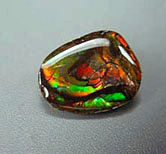
When small, flat pieces of gem material are set within a recess in a stone tablet to create a pattern or picture, the result is called an intarsia. Some of these creations are reminiscent of minature mosaics and are executed with superb precision and skill.
If, instead, such pieces are set into channels within metal, the term inlay is used. Intarsias and inlays illustrate both reasons #1 and #2 for making assembled stones, in that they allow use of small or thin pieces which might otherwise be discarded, and they also provide a unique and lovely gem product, not found in nature.
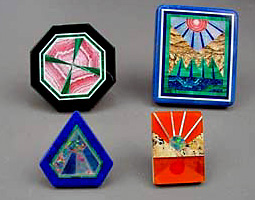
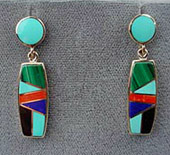
Another example of a beautiful man-made creation is the Mabe pearl. These constructions are made from a usually hollow, blister "pearl" harvested from the shell of the Mabe, or butterfly shell mollusc. Not technically a pearl, since it is formed from the shell of the animal, rather than within its body, this mother-of-pearl blister is cut from the shell, filled with a special cement and a mother-of-pearl bead, then cemented to a mother-of-pearl back. These products come in a variety of sizes and styles, and with their flat backs are easily settable. Compared to cultured pearls of the same size, Mabes are quite inexpensive.
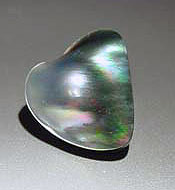
Since the advent of reasonably priced synthetics, the number and variety of assembled stones produced for reasons #3 & #4 have diminished. Historically, a foilback, called the "Rhinestone" was an important product of this type. Applying a metal foil or metallic paint backing to a gem, allows it to simulate a much more brilliant material. Rock crystal quartz stones from the Rhine Valley were the first widely used product to receive this treatment, and were once a common choice as diamond simulants. Later the quartz was replaced by glass, but the name stuck. One of my most cherished mementos from my mother is her circa 1940 Rhinestone necklace and earring set. Cubic zirconia is presently the most common diamond simulant on the market, but to my mind lacks the charm of those Rhinestones.
Even though synthetic emerald is widely available, as synthetics go, it is quite expensive. This creates a need for a good looking, less expensive substitute. As it turns out, the inexpensive flame fusion process which is used to make synthetic corundum and synthetic spinel in a great variety of colors, cannot yet create a convincing emerald green color. That job is most often filled, at present, by the synthetic spinel triplet. This creation is sold by the thousands, if not millions, as the imitiation May birthstone and in high school and college class rings. This clever, and actually, pretty decent looking, assemblage, consists of a colorless synthetic spinel crown cemeted to a colorless synthetic spinel pavilion with a central layer of green glue or green glass.
Although assembled stones had their heydey as deliberate fakes in earlier times, before cheap synthetics made them all but obsolete, there are still some around today to watch out for--> especially if you are purchasing antique jewelry. The most famous example is the garnet and glass doublet. This piece of trickery, if done well, is extremely convincing (I can attest to this personally, as I mis-identified one early in my GIA coursework). The pavilion, and most of the crown of one of these pieces is glass, which can be of almost any color. Red for ruby, blue for sapphire, green for emerald, etc. A thin slice of natural garnet (usually red) is fused by heat and pressure (or sometimes, less convincingly, glued) to the center area of the crown. Then the assemblage is faceted. Although it sounds like you should be able to pick these out a mile away, well done pieces show no red color, face up, and no eye-visible demarkation between the glass and the garnet. The garnet provides durability, high luster and brilliance and even some natural looking inclusions when magnified. Once placed in a setting they are excellent forgeries and would pass all but the most thorough examinations.
A doublet, foilback, or any other assembled stone, can be a fake if it is mis-represented as a natural or solid gem, and when set in a closed bezel may look completely convincing. Unset gems are much more difficult to pass off as something they aren't. To illustrate, if you look at a solid opal from the side, it is obvious that you are seeing a single, uniform material. Look at an opal doublet from the side, and you'll see a sharp demarcation in a straight line between the opal and the base. (Natural boulder or matrix opals when viewed this way have irregularities and undulations between their opal layer and the matrix which makes them easy to distinguish from either a solid piece or a doublet.) Triplets are the easiest of all to identify, even when set, as their colorless crown is obvious from just about any angle.
It would take many pages to catalog the multitude of assembled fakes that have been, and are still, occasionally, being used. There certainly has been no shortage of human ingenuity in this department. Deceivers will try just about anything, and sad to say, they still, sometimes, find willing buyers. Reputable dealers fully disclose the nature of the materials they sell. The current AGTA standards for labeling assembled gems for sale, specify the following gem ehancement code: [Gec: ASBL].
The care and wearing recommendations for assembled stones, vary with the materials involved and method of assembly, but certainly ultrasonic and steam cleaning should be avoided. It would also be prudent to have such stones removed, when jewelry containing them is repaired or sized. In general, erring on the side of caution would be a good idea.
For the most part, even though they have been used to deceive, assembled stones have brought increased variety, beauty, practicality and affordability to the gem marketplace.